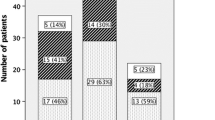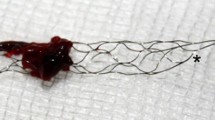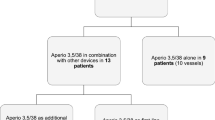Abstract
Background
Trevo Provue stent retriever with visible struts under fluoroscopy may be useful in identifying the optimal position and expansion of the stent during the procedure. This study aimed to demonstrate and analyze changes in the segmental diameter of a radio-opaque stent retriever after deployment according to recanalization results, and its relationship with the angle of the occluded segment of the middle cerebral artery (MCA).
Methods
Forty-one patients who underwent mechanical thrombectomy using a Trevo stent retriever were divided into two groups according to Thrombolysis in Cerebral Infarction (TICI) score (TICI 0-2a and TICI 2b/3). The proximal (Pt), middle (Mt), and distal diameter (Dt) of the deployed stent, at three post-deployment waiting times (t = 0, 3, and 5 min), were measured, and ratios of Mt to Pt (Mt/Pt) and of Mt to Dt (Mt/Dt) were calculated.
Results
TICI 2b/3 was achieved in 31 patients (75.6%) and TICI 0-2a in 10 patients (24.4%). In the TICI 2b/3 group, both changes of Mt/Pt (P < 0.001) and Mt/Dt (P = 0.001) until 3 min were significant and all Mt/Pt (each P < 0.01), M3/D3 (P = 0.014), and M5/D5 (P = 0.012) were significantly larger than those in the TICI 0-2a group. The angle of the MCA was significantly correlated with Mt/Pt and Mt/Dt (P < 0.001).
Conclusion
The diameter of the stent retriever after deployment was associated with the recanalization results in mechanical thrombectomy following MCA occlusion.







Similar content being viewed by others
References
Behme D, Kowoll A, Weber W, Mpotsaris A (2015) M1 is not M1 in ischemic stroke: the disability-free survival after mechanical thrombectomy differs significantly between proximal and distal occlusions of the middle cerebral artery M1 segment. J Neurointerv Surg 7:559–563
Berkhemer OA, Fransen PS, Beumer D, van den Berg LA, Lingsma HF, Yoo AJ, Schonewille WJ, Vos JA, Nederkoorn PJ, Wermer MJ, van Walderveen MA, Staals J, Hofmeijer J, van Oostayen JA, Lycklama a Nijeholt GJ, Boiten J, Brouwer PA, Emmer BJ, de Bruijn SF, van Dijk LC, Kappelle LJ, Lo RH, van Dijk EJ, de Vries J, de Kort PL, van Rooij WJ, van den Berg JS, van Hasselt BA, Aerden LA, Dallinga RJ, Visser MC, Bot JC, Vroomen PC, Eshghi O, Schreuder TH, Heijboer RJ, Keizer K, Tielbeek AV, den Hertog HM, Gerrits DG, van den Berg-Vos RM, Karas GB, Steyerberg EW, Flach HZ, Marquering HA, Sprengers ME, Jenniskens SF, Beenen LF, van den Berg R, Koudstaal PJ, van Zwam WH, Roos YB, van der Lugt A, van Oostenbrugge RJ, Majoie CB, Dippel DW, Investigators MC (2015) A randomized trial of intraarterial treatment for acute ischemic stroke. N Engl J Med 372:11–20
Boeckh-Behrens T, Schubert M, Forschler A, Prothmann S, Kreiser K, Zimmer C, Riegger J, Bauer J, Neff F, Kehl V, Pelisek J, Schirmer L, Mehr M, Poppert H (2016) The impact of histological clot composition in embolic stroke. Clin Neuroradiol 26:189–197
Broussalis E, Trinka E, Hitzl W, Wallner A, Chroust V, Killer-Oberpfalzer M (2013) Comparison of stent-retriever devices versus the merci retriever for endovascular treatment of acute stroke. AJNR Am J Neuroradiol 34:366–372
Campbell BC, Mitchell PJ, Kleinig TJ, Dewey HM, Churilov L, Yassi N, Yan B, Dowling RJ, Parsons MW, Oxley TJ, Wu TY, Brooks M, Simpson MA, Miteff F, Levi CR, Krause M, Harrington TJ, Faulder KC, Steinfort BS, Priglinger M, Ang T, Scroop R, Barber PA, McGuinness B, Wijeratne T, Phan TG, Chong W, Chandra RV, Bladin CF, Badve M, Rice H, de Villiers L, Ma H, Desmond PM, Donnan GA, Davis SM, Investigators E-I (2015) Endovascular therapy for ischemic stroke with perfusion-imaging selection. N Engl J Med 372:1009–1018
Goyal M, Demchuk AM, Menon BK, Eesa M, Rempel JL, Thornton J, Roy D, Jovin TG, Willinsky RA, Sapkota BL, Dowlatshahi D, Frei DF, Kamal NR, Montanera WJ, Poppe AY, Ryckborst KJ, Silver FL, Shuaib A, Tampieri D, Williams D, Bang OY, Baxter BW, Burns PA, Choe H, Heo JH, Holmstedt CA, Jankowitz B, Kelly M, Linares G, Mandzia JL, Shankar J, Sohn SI, Swartz RH, Barber PA, Coutts SB, Smith EE, Morrish WF, Weill A, Subramaniam S, Mitha AP, Wong JH, Lowerison MW, Sajobi TT, Hill MD, Investigators ET (2015) Randomized assessment of rapid endovascular treatment of ischemic stroke. N Engl J Med 372:1019–1030
Gralla J, Burkhardt M, Schroth G, El-Koussy M, Reinert M, Nedeltchev K, Slotboom J, Brekenfeld C (2008) Occlusion length is a crucial determinant of efficiency and complication rate in thrombectomy for acute ischemic stroke. AJNR Am J Neuroradiol 29:247–252
Haussen DC, Rebello LC, Nogueira RG (2015) Optimizating clot retrieval in acute stroke: the push and fluff technique for closed-cell Stentrievers. Stroke 46:2838–2842
Jansen O, Macho JM, Killer-Oberpfalzer M, Liebeskind D, Wahlgren N, Group TS (2013) Neurothrombectomy for the treatment of acute ischemic stroke: results from the TREVO study. Cerebrovasc Dis 36:218–225
Jindal G, Miller T, Shivashankar R, Mitchell J, Stern BJ, Yarbrough K, Gandhi D (2014) Relationship of thrombus length to number of stent retrievals, revascularization, and outcomes in acute ischemic stroke. J Vasc Interv Radiol 25:1549–1557
Jovin TG, Chamorro A, Cobo E, de Miquel MA, Molina CA, Rovira A, San Roman L, Serena J, Abilleira S, Ribo M, Millan M, Urra X, Cardona P, Lopez-Cancio E, Tomasello A, Castano C, Blasco J, Aja L, Dorado L, Quesada H, Rubiera M, Hernandez-Perez M, Goyal M, Demchuk AM, von Kummer R, Gallofre M, Davalos A, Investigators RT (2015) Thrombectomy within 8 hours after symptom onset in ischemic stroke. N Engl J Med 372:2296–2306
Kabbasch C, Mpotsaris A, Chang DH, Hiss S, Dorn F, Behme D, Onur O, Liebig T (2016) Mechanical thrombectomy with the Trevo ProVue device in ischemic stroke patients: does improved visibility translate into a clinical benefit? J Neurointerv Surg 8:778–782
Kim BM (2017) Causes and solutions of endovascular treatment failure. J Stroke 19:131–142
Liebeskind DS, Sanossian N, Yong WH, Starkman S, Tsang MP, Moya AL, Zheng DD, Abolian AM, Kim D, Ali LK, Shah SH, Towfighi A, Ovbiagele B, Kidwell CS, Tateshima S, Jahan R, Duckwiler GR, Vinuela F, Salamon N, Villablanca JP, Vinters HV, Marder VJ, Saver JL (2011) CT and MRI early vessel signs reflect clot composition in acute stroke. Stroke 42:1237–1243
Lobsien D, Gawlitza M, Schaudinn A, Schob S, Hobohm C, Fritzsch D, Quaschling U, Hoffmann KT, Friedrich B (2016) Mechanical thrombectomy versus systemic thrombolysis in MCA stroke: a distance to thrombus-based outcome analysis. J Neurointerv Surg 8:878–882
Madjidyar J, Hermes J, Freitag-Wolf S, Jansen O (2015) Stent-thrombus interaction and the influence of aspiration on mechanical thrombectomy: evaluation of different stent retrievers in a circulation model. Neuroradiology 57:791–797
Nogueira RG, Lutsep HL, Gupta R, Jovin TG, Albers GW, Walker GA, Liebeskind DS, Smith WS, Trialists T (2012) Trevo versus merci retrievers for thrombectomy revascularisation of large vessel occlusions in acute ischaemic stroke (TREVO 2): a randomised trial. Lancet 380:1231–1240
Pereira VM, Gralla J, Davalos A, Bonafe A, Castano C, Chapot R, Liebeskind DS, Nogueira RG, Arnold M, Sztajzel R, Liebig T, Goyal M, Besselmann M, Moreno A, Schroth G (2013) Prospective, multicenter, single-arm study of mechanical thrombectomy using solitaire flow restoration in acute ischemic stroke. Stroke 44:2802–2807
Saver JL, Goyal M, Bonafe A, Diener HC, Levy EI, Pereira VM, Albers GW, Cognard C, Cohen DJ, Hacke W, Jansen O, Jovin TG, Mattle HP, Nogueira RG, Siddiqui AH, Yavagal DR, Baxter BW, Devlin TG, Lopes DK, Reddy VK, du Mesnil de Rochemont R, Singer OC, Jahan R, Investigators SP (2015) Stent-retriever thrombectomy after intravenous t-PA vs t-PA alone in stroke. N Engl J Med 372:2285–2295
Schwaiger BJ, Gersing AS, Zimmer C, Prothmann S (2015) The curved MCA: influence of vessel anatomy on recanalization results of mechanical Thrombectomy after acute ischemic stroke. AJNR Am J Neuroradiol 36:971–976
Schwaiger BJ, Kober F, Gersing AS, Kleine JF, Wunderlich S, Zimmer C, Poppert H, Prothmann S (2016) The pREset stent retriever for endovascular treatment of stroke caused by MCA occlusion: safety and clinical outcome. Clin Neuroradiol 26:47–55
Soize S, Kadziolka K, Estrade L, Serre I, Bakchine S, Pierot L (2013) Mechanical thrombectomy in acute stroke: prospective pilot trial of the solitaire FR device while under conscious sedation. AJNR Am J Neuroradiol 34:360–365
van der Marel K, Chueh JY, Brooks OW, King RM, Marosfoi MG, Langan ET, Carniato SL, Gounis MJ, Nogueira RG, Puri AS (2016) Quantitative assessment of device-clot interaction for stent retriever thrombectomy. J Neurointerv Surg 8:1278–1282
Wiesmann M, Brockmann MA, Heringer S, Muller M, Reich A, Nikoubashman O (2017) Active push deployment technique improves stent/vessel-wall interaction in endovascular treatment of acute stroke with stent retrievers. J Neurointerv Surg 9:253–256
Yi HJ, Lee DH, Sung JH (2018) Clinical usefulness of waiting after stent deployment in mechanical thrombectomy: effect of the clot integration. World Neurosurg 119:e87–e93
Yi HJ, Sung JH, Lee DH, Hong JT, Lee SW (2017) Single-center experience of mechanical thrombectomy with the Trevo XP ProVue 6 x 25 mm stent retriever in middle cerebral artery occlusion: comparison with Trevo XP ProVue 4 x 20 mm. World Neurosurg 107:649–656
Yuki I, Kan I, Vinters HV, Kim RH, Golshan A, Vinuela FA, Sayre JW, Murayama Y, Vinuela F (2012) The impact of thromboemboli histology on the performance of a mechanical thrombectomy device. AJNR Am J Neuroradiol 33:643–648
Zhu L, Liebeskind DS, Jahan R, Starkman S, Salamon N, Duckwiler G, Vinuela F, Tateshima S, Gonzalez N, Villablanca P, Ali LK, Kim D, Ovbiagele B, Froehler M, Tenser M, Saver JL (2012) Thrombus branching and vessel curvature are important determinants of middle cerebral artery trunk recanalization with Merci thrombectomy devices. Stroke 43:787–792
Author information
Authors and Affiliations
Corresponding author
Ethics declarations
All procedures performed in this study were in accordance with the ethical standards of the institute and with the 1964 Helsinki Declaration and its later amendments. Formal consent was not required for the collection of this data.
Informed consent
For this type of study, formal consent is not required.
Conflict of interest
The authors declare that they have no conflict of interest.
Additional information
Comments
The authors describe the progressive enlargement of the Trevo stent within a delay of 5 min when placed in the middle cerebral artery during mechanical thrombectomy. The Trevo has the unique advantage of being visible along its entire course, allowing to see the level of wall apposition. According to Choi et al., this is an important prognostic factor in the ability of the stentretriever to extract the clot. This finding has the following consequences:
– Clinical studies and not only experimental studies as achieved up to now need to be done in order to determine whether waiting for several minutes after placement of a stent retriever is needed to achieve a better recanalization but also better clinical outcome as this waiting time has negative consequences in relation to delay of restoral of normal brain perfusion
– All stent retrievers that will be released in the future should be visible in order to assess the level of expansion of the stent retriever
– There is no satisfactory reliable way to compare stent retrievers up to now. The first pass rate seems to be a possible way. The time for complete expansion, as evaluated in this study, may be another way to achieve a comparative analysis among stent retrievers
Rene Chapot
Essen, Germany
Publisher’s note
Springer Nature remains neutral with regard to jurisdictional claims in published maps and institutional affiliations.
This article is part of the Topical Collection on Vascular Neurosurgery – Ischemia
Rights and permissions
About this article
Cite this article
Choi, D.H., Yoo, C.J., Park, C.W. et al. Gradual expansion of stent retriever in mechanical thrombectomy for curved middle cerebral artery: structural findings of the stent for predictable recanalization results. Acta Neurochir 161, 2003–2012 (2019). https://doi.org/10.1007/s00701-019-03938-w
Received:
Accepted:
Published:
Issue Date:
DOI: https://doi.org/10.1007/s00701-019-03938-w




